tire pressure CHEVROLET BLAZER 1998 2.G Owners Manual
[x] Cancel search | Manufacturer: CHEVROLET, Model Year: 1998, Model line: BLAZER, Model: CHEVROLET BLAZER 1998 2.GPages: 416, PDF Size: 22.4 MB
Page 190 of 416

Downloaded from www.Manualslib.com manuals search engine You slam on the brakes. Here’s what happens with ABS.
A computer senses that wheels are slowing down. If one
of the wheels is about to stop rolling, the computer will
separately work the brakes at each front wheel and at
both rear wheels.
The anti-lock system can change the brake pressure
faster than any driver could. The computer
is
programmed to make the most of available tire and
road conditions. You
can steer around the obstacle while braking hard.
As you brake, your computer keeps receiving updates on
wheel speed and controls braking pressure accordingly.
Remember: Anti-lock doesn’t change the time you need
to get your foot up to the brake pedal or always decrease
stopping distance.
If you get too close to the vehicle in
front of
you, you won’t have time to apply your brakes
if that vehicle suddenly slows or stops. Always leave
enough room up ahead to stop, even though
you have
anti-lock brakes.
Using Anti-Lock
Don’t pump the brakes. Just hold the brake pedal down
firmly and let anti-lock work for
you. You may feel the
brakes vibrate, or
you may notice some noise, but this is
normal. On vehicles with four-wheel drive, your
anti-lock brakes work at all times
-- whether you are in
two-wheel drive or four-wheel drive,
Braking in Emergencies
With anti-lock, you can steer and brake at the same
time. In many emergencies, steering can help
you more
than even the very best braking.
4-8
Page 207 of 416
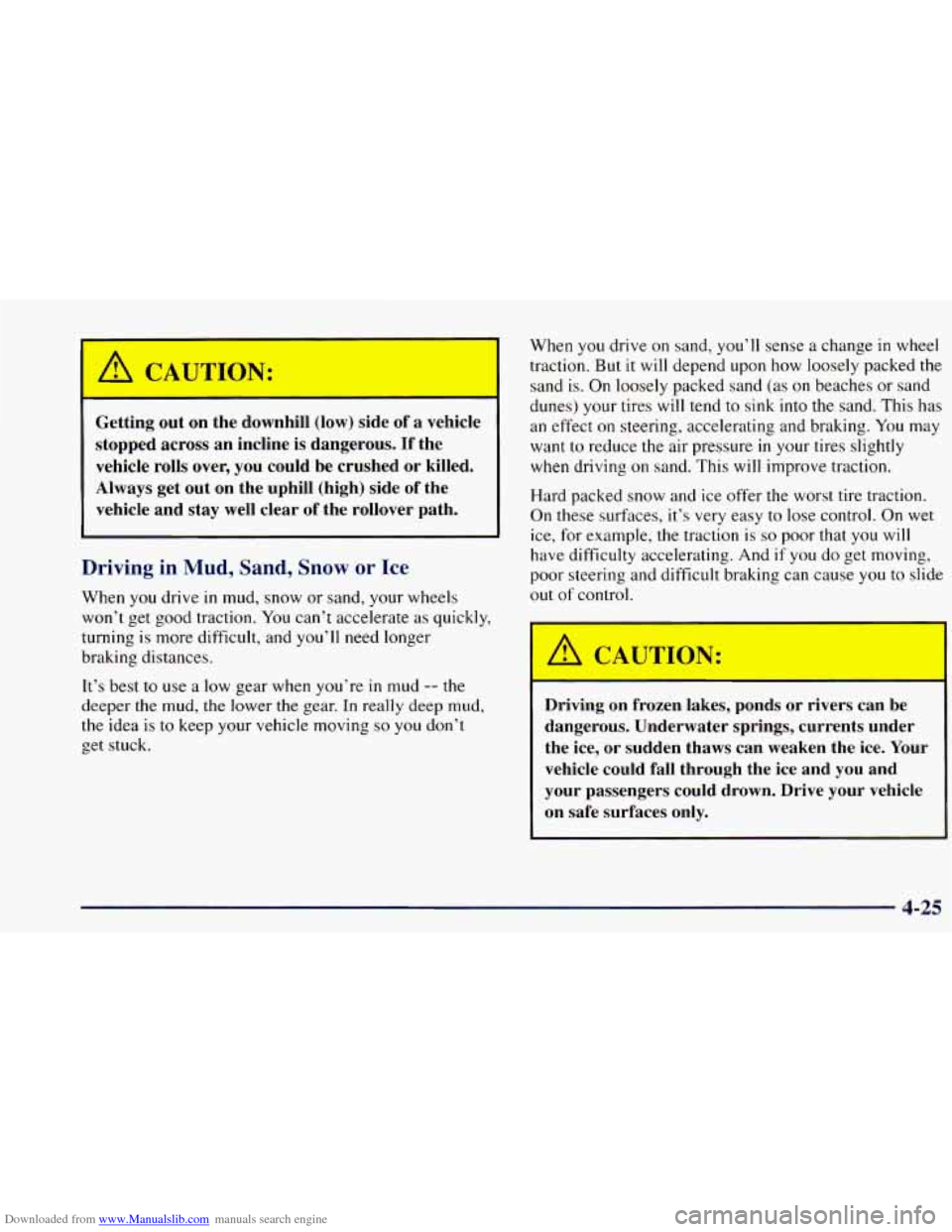
Downloaded from www.Manualslib.com manuals search engine A CAUTION:
Getting out on the downhill (low) side of
stopped across an incline is dangerous. If the
vehicle rolls
over, you could be crushed or killed.
Always get out on the uphill (high) side of the
vehicle and stay well clear of the rollover path.
Driving in d, md, Snow or Ice
When you drive in mud, snow or sand, your wheels
won’t get good traction.
You can’t accelerate as quickly,
turning
is more difficult, and you’ll need longer
braking distances.
It’s best
to use a low gear when you’re in mud -- the
deeper
the mud, the lower the gear. In really deep mud,
the idea is to keep your vehicle moving so you don’t
get stuck. When you drive on
sand, you’ll sense a change
in wheel
traction. But it
will depend upon how loosely packed the
sand
is. On loosely packed sand (as on beaches or sand
dunes) your tires will tend to sink into the sand. This has
an effect
on steering, accelerating and braking. You may
want to reduce the air pressure
in your tires slightly
when driving on sand. This will improve traction.
Hard packed
snow and ice offer the worst tire traction.
On these surfaces, it’s very easy
to lose control. On wet
ice, for example, the traction is so poor that you will
have difficulty accelerating. And if
you do get moving,
poor steering and difficult braking can cause
you to slide
out of control.
Driving on frozen lakes, ponds or rivers can be
dangerous. Underwater springs, currents under
the ice, or sudden thaws can weaken the ice. Your
vehicle could fall through the ice and you and
your passengers could drown. Drive your vehicle
on safe surfaces only.
4-25
Page 212 of 416
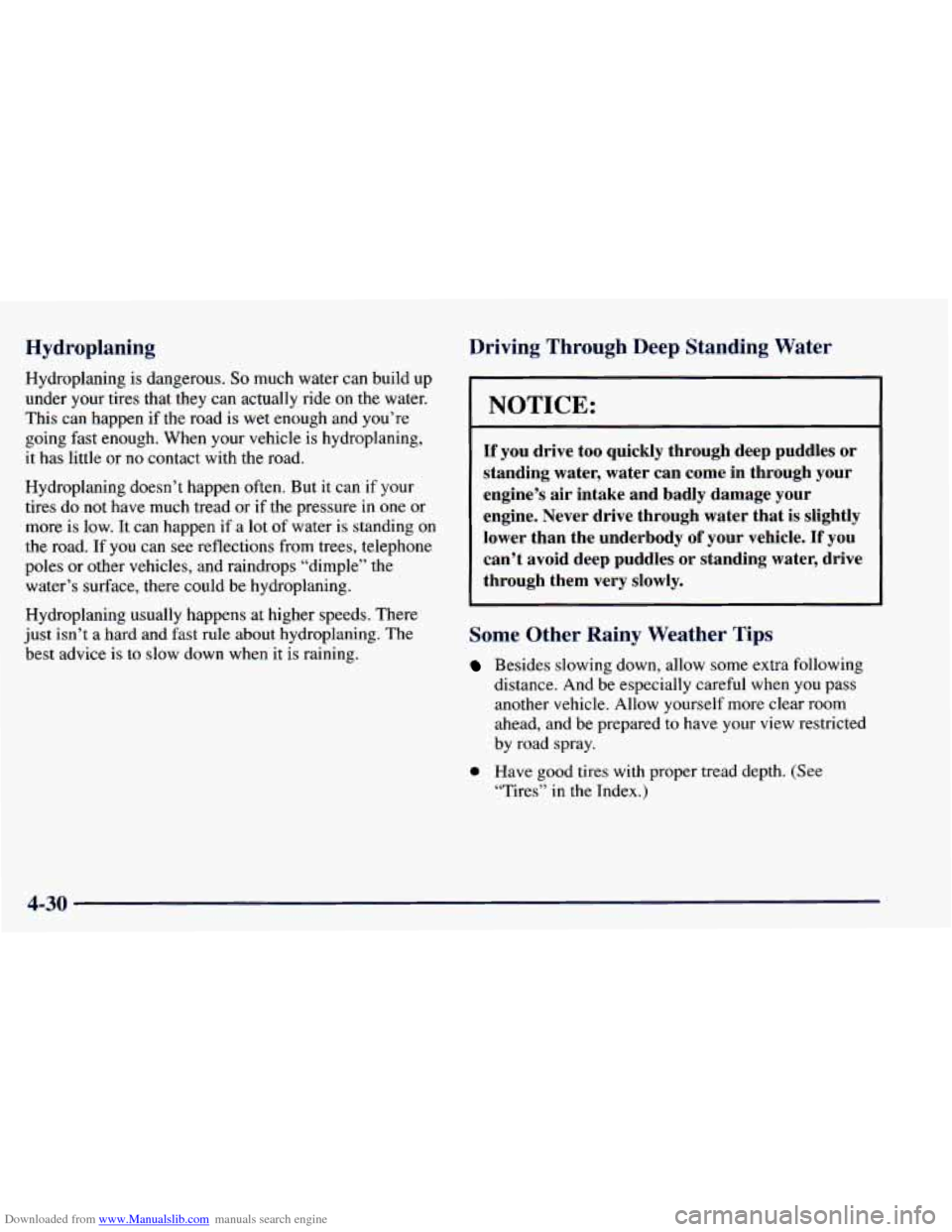
Downloaded from www.Manualslib.com manuals search engine Hydroplaning
Hydroplaning is dangerous. So much water can build up
under your tires that they can actually ride on the water.
This can happen if the road is wet enough and you’re
going fast enough. When your vehicle is hydroplaning,
it has little or no contact with the road.
Hydroplaning doesn’t happen often. But it can if your
tires do not have much tread or if the pressure
in one or
more is low.
It can happen if a lot of water is standing on
the road. If you can see reflections from trees, telephone poles or other vehicles, and raindrops “dimple” the
water’s surface, there could
be hydroplaning.
Hydroplaning usually happens at higher speeds. There
just isn’t
a hard and fast rule about hydroplaning. The
best advice is to slow down when it is raining.
Driving Through Deep Standing Water
I I
NOTICE:
If you drive too quickly through deep puddles or
standing water, water can come in through your engine’s air intake and badly damage your
engine. Never drive through water that
is slightly
lower than the underbody
of your vehicle. If you
can’t avoid deep puddles or standing water, drive
through them very slowly.
I I
Some Other Rainy Weather Tips
Besides slowing down, allow some extra following
distance. And be especially careful when
you pass
another vehicle. Allow yourself more clear room
ahead, and be prepared to have your
view restricted
by road spray.
0 Have good tires with proper tread depth. (See “Tires”
in the Index.)
4-30
Page 215 of 416
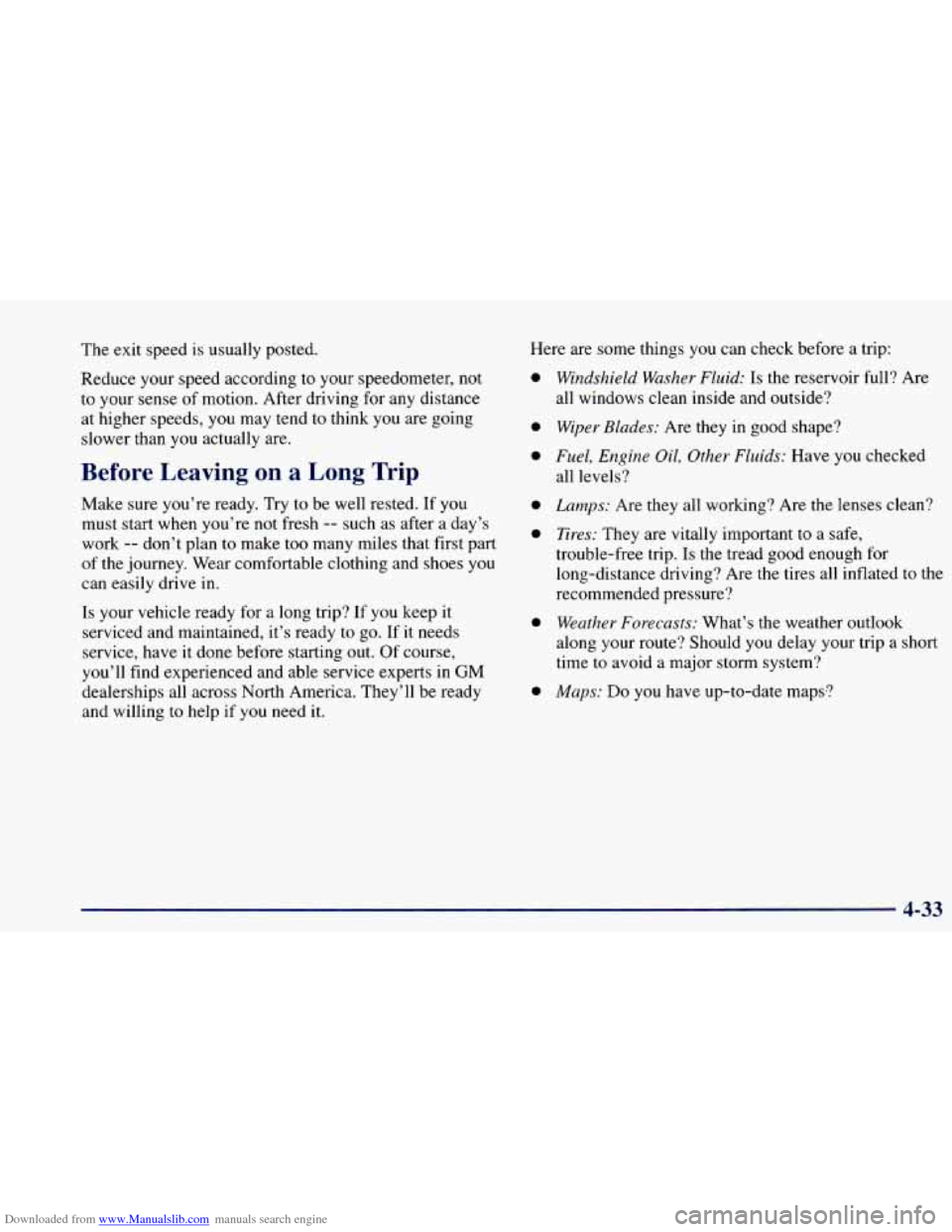
Downloaded from www.Manualslib.com manuals search engine The exit speed is usually posted.
Reduce your speed according to your speedometer,
not
to your sense of motion. After driving for any distance
at higher speeds,
you may tend to think you are going
slower than
you actually are.
Before Leaving on a Long Trip
Make sure you’re ready. Try to be well rested. If you
must start when you’re not fresh -- such as after a day’s
work
-- don’t plan to make too many miles that first part
of the journey. Wear comfortable clothing and shoes you
can easily drive in.
Is your vehicle ready for a long trip? If you keep it
serviced and maintained, it’s ready to go. If it needs
service, have it done before starting out. Of course,
you’ll find experienced and able service experts in GM
dealerships all across North America. They’ll be ready
and willing
to help if you need it. Here are
some things you can check before
a trip:
0
0
0
0
0
0
0
Windshield Washer Fluid: Is the reservoir full? Are
all windows clean inside and outside?
Wiper Blades: Are they in good shape?
Fuel, Engine Oil, Other Fluids: Have you checked
all levels?
Lamps: Are they all working? Are the lenses clean?
Tires: They are vitally important to a safe,
trouble-free trip.
Is the tread good enough for
long-distance driving? Are the tires all inflated to the
recommended pressure?
Weather Forecasts: What’s the weather outlook
along your route? Should
you delay your trip a short
time
to avoid a major storm system?
Maps: Do you have up-to-date maps?
4-33
Page 222 of 416
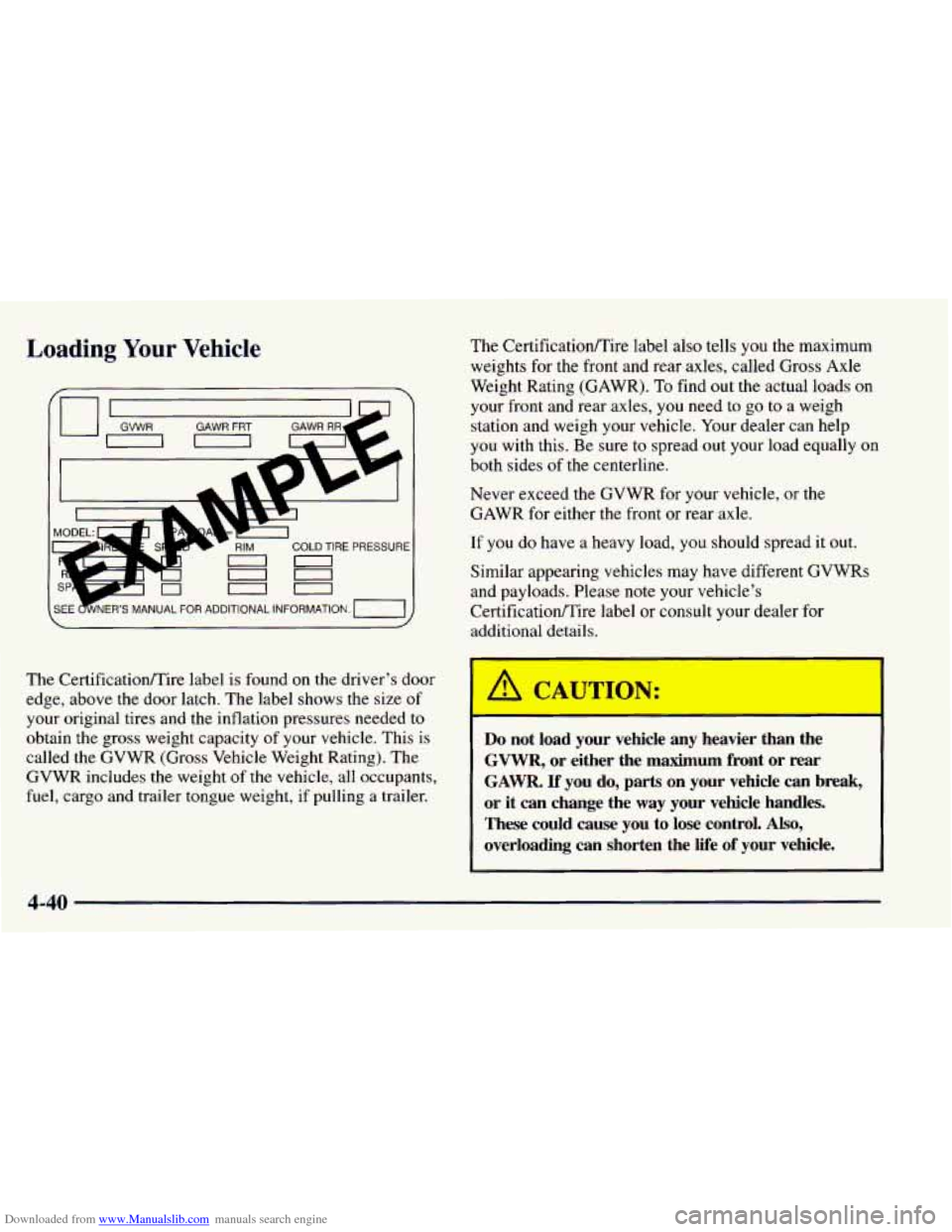
Downloaded from www.Manualslib.com manuals search engine Loading Your Vehicle
I, 1
COLD TIRE PRESSURE . - uu
on
00
\SEE FNER’S MANUAL FOR ADDITIONAL INFORMATION. TI I
The Certification/Tire label is found on the driver’s door
edge, above the door latch. The label shows the size
of
your original tires and the inflation pressures needed to
obtain the gross weight capacity
of your vehicle. This is
called the GVWR (Gross Vehicle Weight Rating). The
GVWR includes the weight of the vehicle, all occupants,
fuel, cargo and trailer tongue weight, if pulling a trailer. The
Certificatioflire label
also tells you the maximum
weights for the front and rear axles, called Gross Axle
Weight Rating (GAWR).
To find out the actual loads on
your front and rear axles, you need to go to a weigh
station and weigh your vehicle. Your dealer can help
you with this. Be sure to spread out your load equally on
both sides of the centerline.
Never exceed
the GVWR for your vehicle, or the
GAWR for either the front
or rear axle.
If you do have a heavy load,
you should spread it out.
Similar appearing vehicles may have different GVWRs
and payloads. Please note your vehicle’s
CertificationjTire label or consult your dealer for
additional details.
/A CAULON:
Do not load your vehicle any heavier than the
GVWR, or either the maximum front or rear
GAWR. If you do, parts on your vehicle can break,
or it can change the way your vehicle handles.
These could cause you to lose control.
Also,
overloading can shorten the life of your vehicle.
4-40
Page 266 of 416
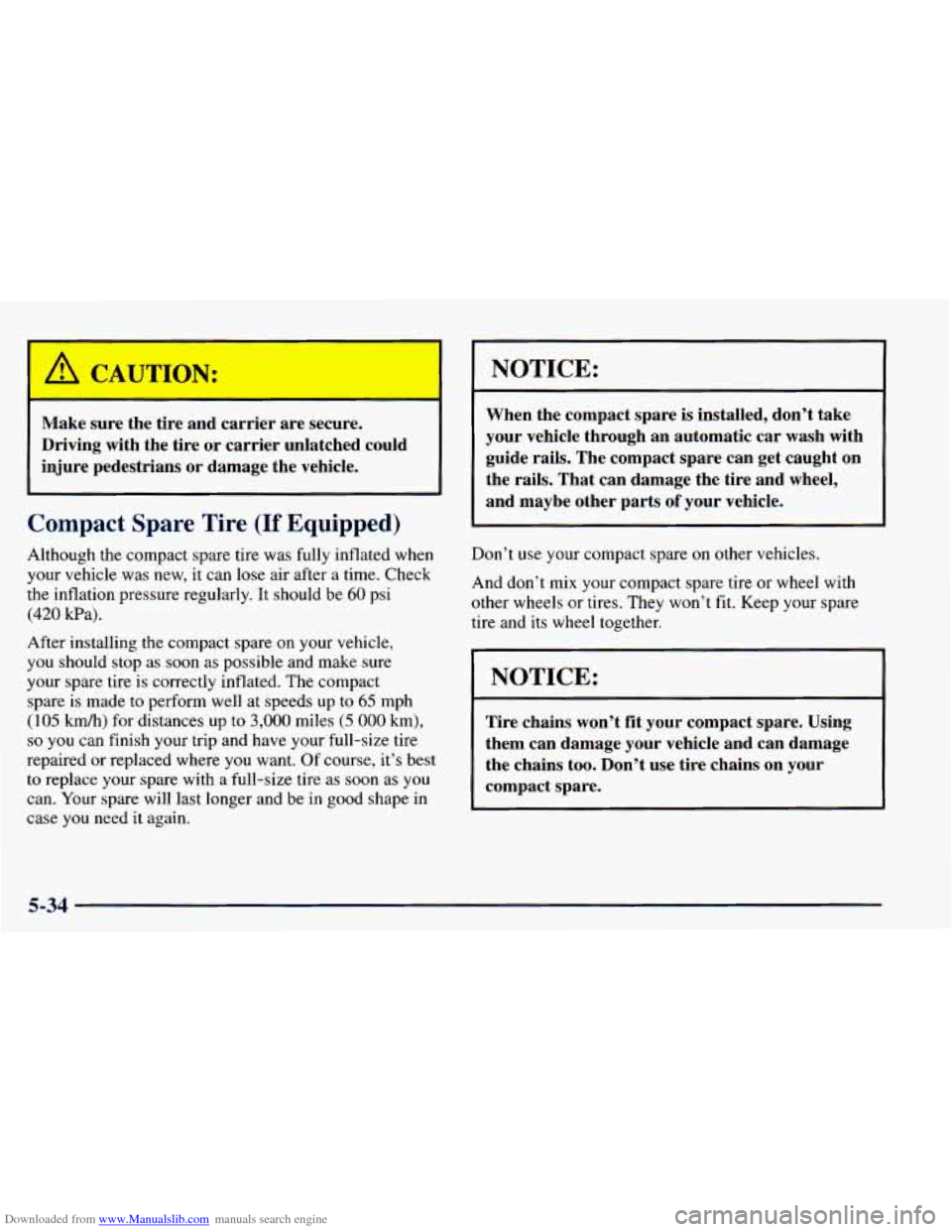
Downloaded from www.Manualslib.com manuals search engine ’ CAUTION:
Make sure the tire and carrier are secure.
Driving with the tire or carrier unlatched could
injure pedestrians or damage the vehicle.
Compact Spare Tire (If Equipped)
Although the compact spare tire was fully inflated when
your vehicle was new, it can lose air after a time. Check
the inflation pressure regularly. It should be
60 psi
(420 kPa).
After installing the compact spare on your vehicle,
you should stop as soon as possible and make sure
your spare tire
is correctly inflated. The compact
spare
is made to perform well at speeds up to 65 mph
(105 Wh) for distances up to 3,000 miles (5 000 km),
so you can finish your trip and have your full-size tire
repaired or replaced where
you want. Of course, it’s besf
to replace your spare with a full-size tire as soon as you
can. Your spare will last longer and be in good shape in
case you need it again.
NOTICE:
When the compact spare is installed, don’t take
your vehicle through an automatic car wash with
guide rails. The compact spare can get caught on
the rails. That can damage
the tire and wheel,
and maybe other parts
of your vehicle.
Don’t use your compact spare on other vehicles.
And don’t mix your compact spare tire or wheel with
other wheels or tires. They won’t fit. Keep your spare
tire and its wheel together.
NOTICE:
Tire chains won’t fit your compact spare. Using
them can damage your vehicle and can damage
the chains too. Don’t use tire chains on your
compact spare.
5-34
Page 271 of 416
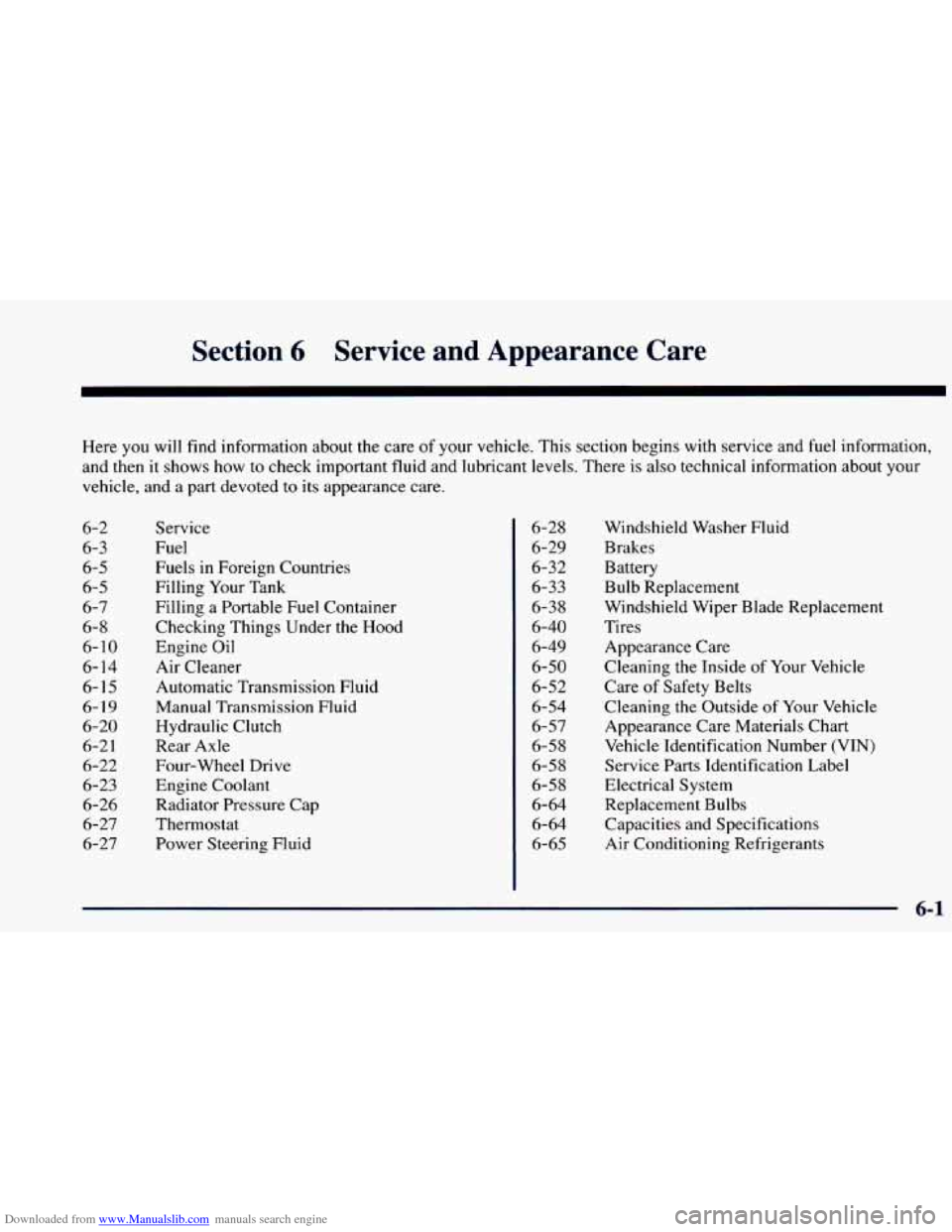
Downloaded from www.Manualslib.com manuals search engine Section 6 Service and Appnara-- ~2 Care
Here you will find information about the care of your vehicle. This section begins with service and fuel information,
and then it shows how to check important fluid and lubricant levels. There is also technical information about your
vehicle, and a part devoted to its appearance care.
6-2
6-3
6-5
6-5
6-7
6-8
6-10
6- 14
6-15
6-1 9
6-20
6-2
1
6-22 6-23
6-26 6-27
6-27
Service
Fuel
Fuels
in Foreign Countries
Filling Your Tank
Filling a Portable Fuel Container
Checking Things Under the Hood
Engine Oil
Air Cleaner
Automatic Transmission Fluid
Manual Transmission Fluid
Hydraulic Clutch
Rear Axle
Four-wheel Drive
Engine Coolant
Radiator Pressure Cap
Thermostat Power Steering Fluid 6-28
6-29
6-32
6-33
6-38
6-40
6-49
6-50
6-52
6-54
6-57
6-58
6-58
6-58
6-64 6-64
6-65 Windshield Washer Fluid
Brakes
Battery
Bulb Replacement
Windshield Wiper Blade Replacement
Tires
Appearance Care
Cleaning the Inside of Your Vehicle
Care
of Safety Belts
Cleaning the Outside
of Your Vehicle
Appearance Care Materials Chart
Vehicle Identification Number (VTN)
Service Parts Identification Label
Electrical System
Replacement Bulbs Capacities and Specifications
Air Conditioning Refrigerants
Page 311 of 416
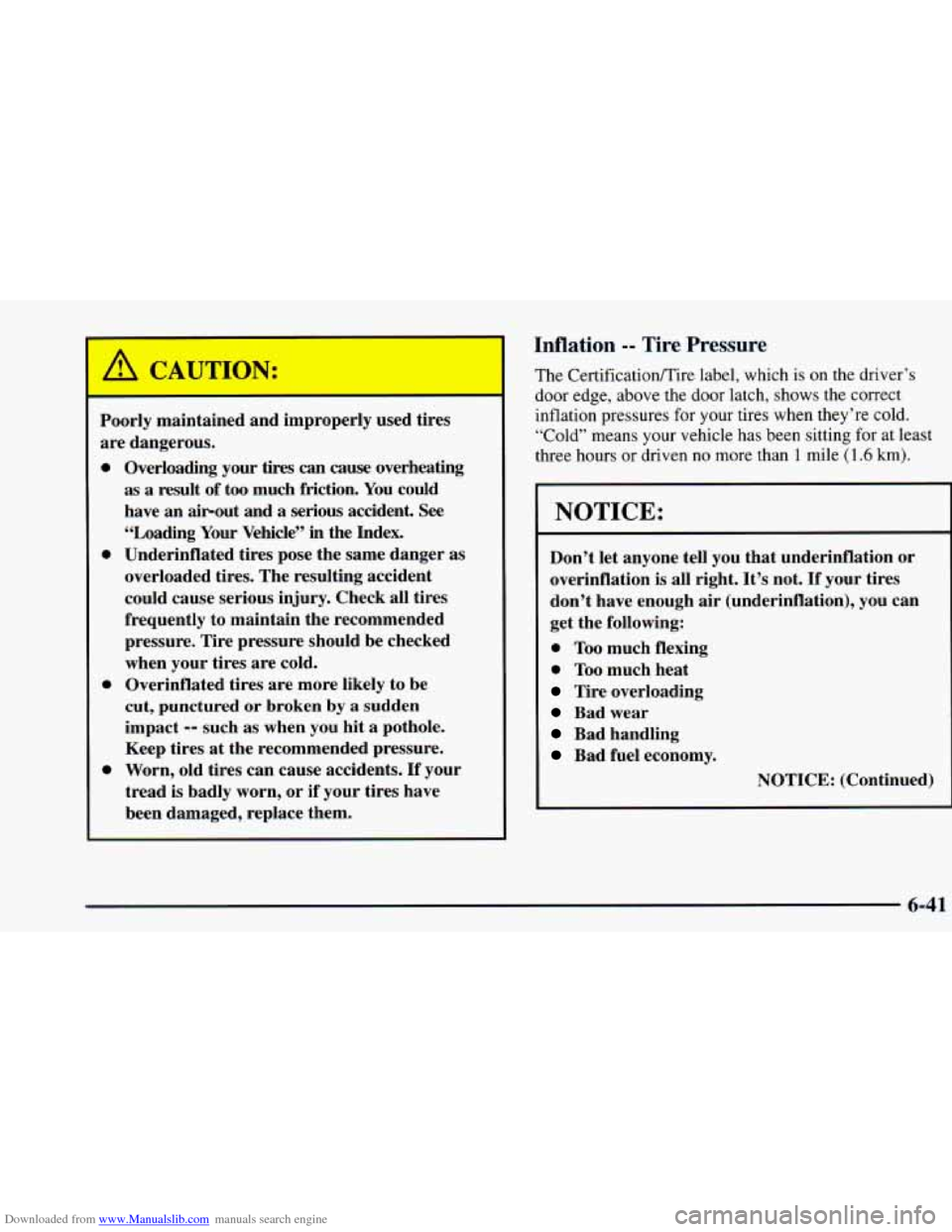
Downloaded from www.Manualslib.com manuals search engine I
Poorly maintained and improperly used tires are dangerous.
0
0
0
0
Overloading your tires can cause overheating
as a result of too much friction.
You could
have an airout and a serious accident.
See
“Loading Your Vehicle” in the Index.
Underinflated tires pose the same danger as
overloaded tires. The resulting accident
could cause serious injury. Check all tires
frequently to maintain the recommended pressure. Tire pressure should be checked when your tires are cold.
Overinflated tires are more likely to be
cut, punctured or broken by
a sudden
impact
-- such as when you hit a pothole.
Keep tires at the recommended pressure.
Worn, old tires can cause accidents.
If your
tread is badly worn, or if your tires have
been damaged, replace them.
Inflation -- Tire Pressure
The CertificatiodTire label, which is on the driver’s
door edge, above the door latch, shows the correct
inflation pressures for your tires when they’re cold.
“Cold” means your vehicle has been sitting
for at least
three hours or driven
no more than 1 mile (1.6 km).
NOTICE:
Don’t let anyone tell you that underinflation or
overinflation is all right. It’s not.
If your tires
don’t have enough air (underinflation), you can
get the following:
0 Too much flexing
0 Too much heat
Tire overloading
Bad wear
Bad handling
Bad fuel economy.
NOTICE: (Continued)
6-41
Page 312 of 416
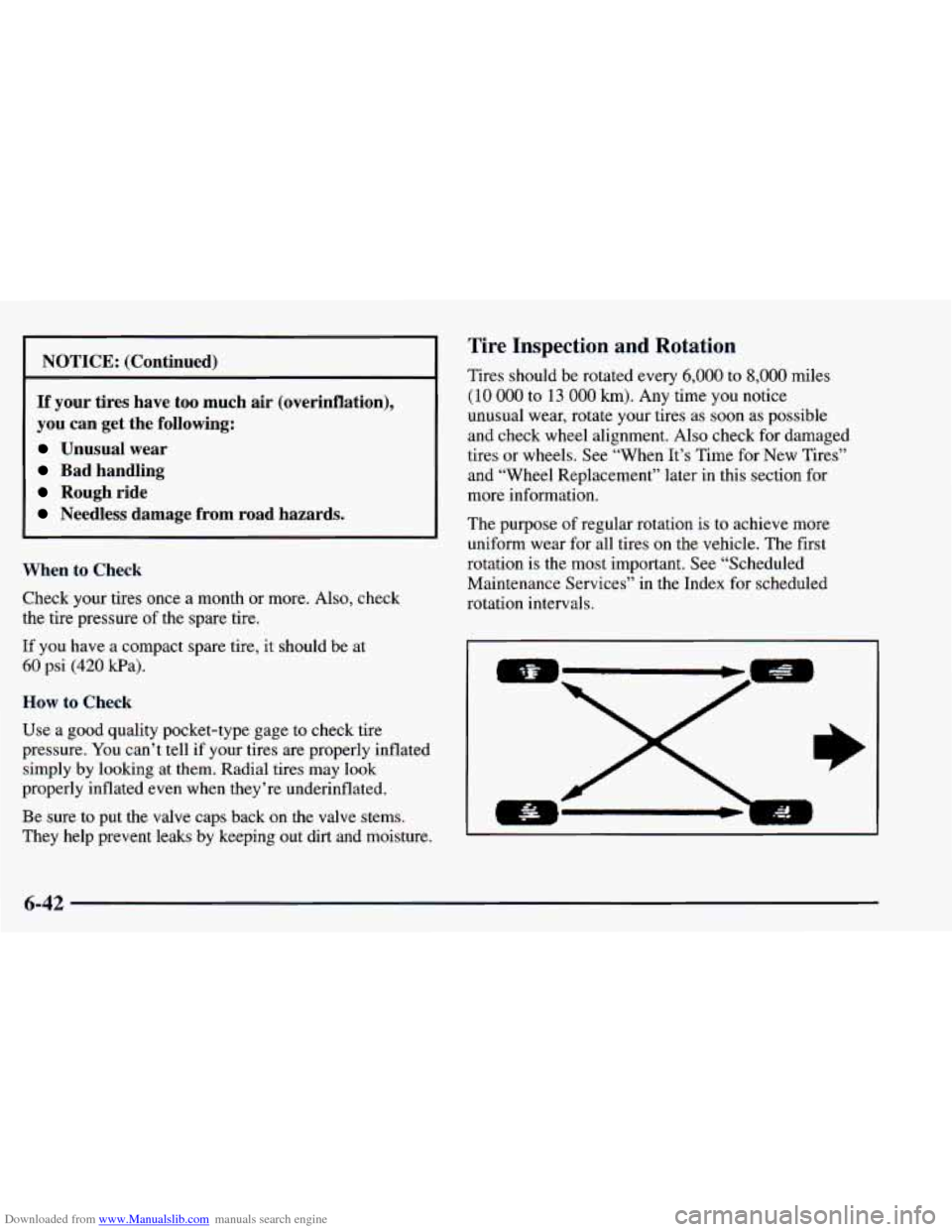
Downloaded from www.Manualslib.com manuals search engine I NOTICE: (Continued) I
If your tires have too much air (overinflation),
you can get the following:
Unusual wear
Bad handling
Rough ride
Needless damage from road hazards.
When
to Check
Check your tires once a month or more. Also, check
the tire pressure of the spare tire.
If you have a compact spare tire, it should be at
60 psi (420 Wa).
How to Check
Use a good quality pocket-type gage to check tire
pressure. You can’t tell if your tires are properly inflated
simply by looking
at them. Radial tires may look
properly inflated even when they’re underinflated.
Be sure to put the valve caps back on the valve stems.
They help prevent leaks by keeping out dirt and moisture.
Tire Inspection and Rotation
Tires should be rotated every 6,000 to 8,000 miles
(10
000 to 13 000 km). Any time you notice
unusual wear, rotate your tires as soon as possible
and check wheel alignment. Also check for damaged
tires or wheels. See “When It’s Time for New Tires”
and “Wheel Replacement” later in this section for
more information.
The purpose of regular rotation is to achieve more
uniform wear for all tires on the vehicle. The first
rotation is the most important. See “Scheduled
Maintenance Services’’ in the Index for scheduled
rotation intervals.
6-42
Page 313 of 416
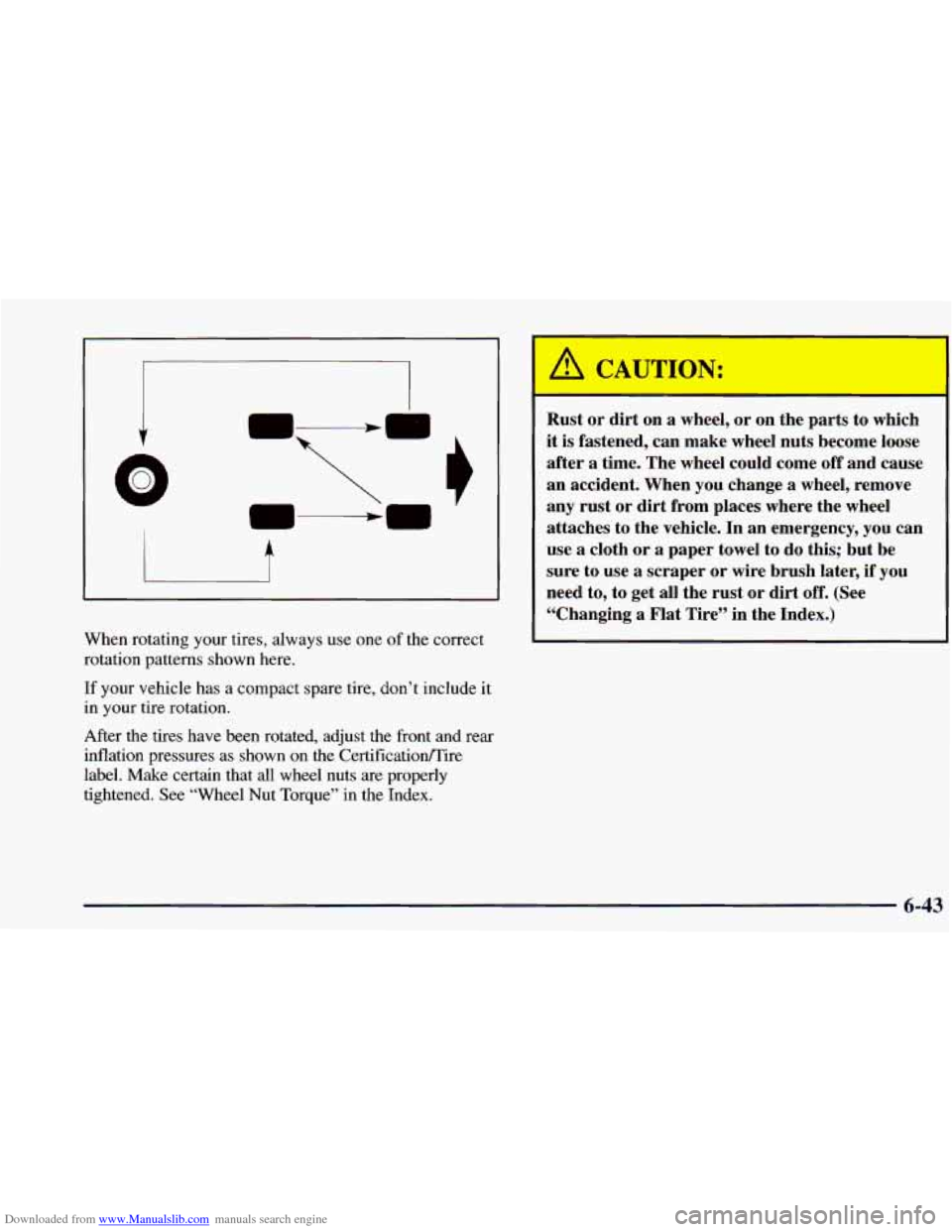
Downloaded from www.Manualslib.com manuals search engine 1
Q
i
When rotating your tires, always use one of the correct
rotation patterns shown here.
If your vehicle has a compact spare tire, don’t include it
in your tire rotation.
After the tires have been rotated, adjust the front and rear
inflation pressures as shown on the Certificatiomire
label.
Make certain that all wheel nuts are properly
tightened. See “Wheel Nut Torque” in the
Index.
A C. UTION:
Rust or dirt on a wheel, or on the parts to which
it is fastened, can make wheel nuts become loose
after a time. The wheel could come
off and cause
an accident. When you change a wheel, remove
any rust or dirt from places where the wheel
attaches to the vehicle. In an emergency, you can
use
a cloth or a paper towel to do this; but be
sure to use a scraper or wire brush later, if you
need
to, to get all the rust or dirt off. (See
“Changing a Flat Tire” in the Index.)
6-43